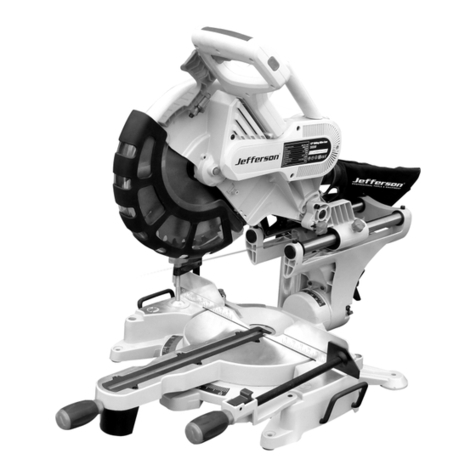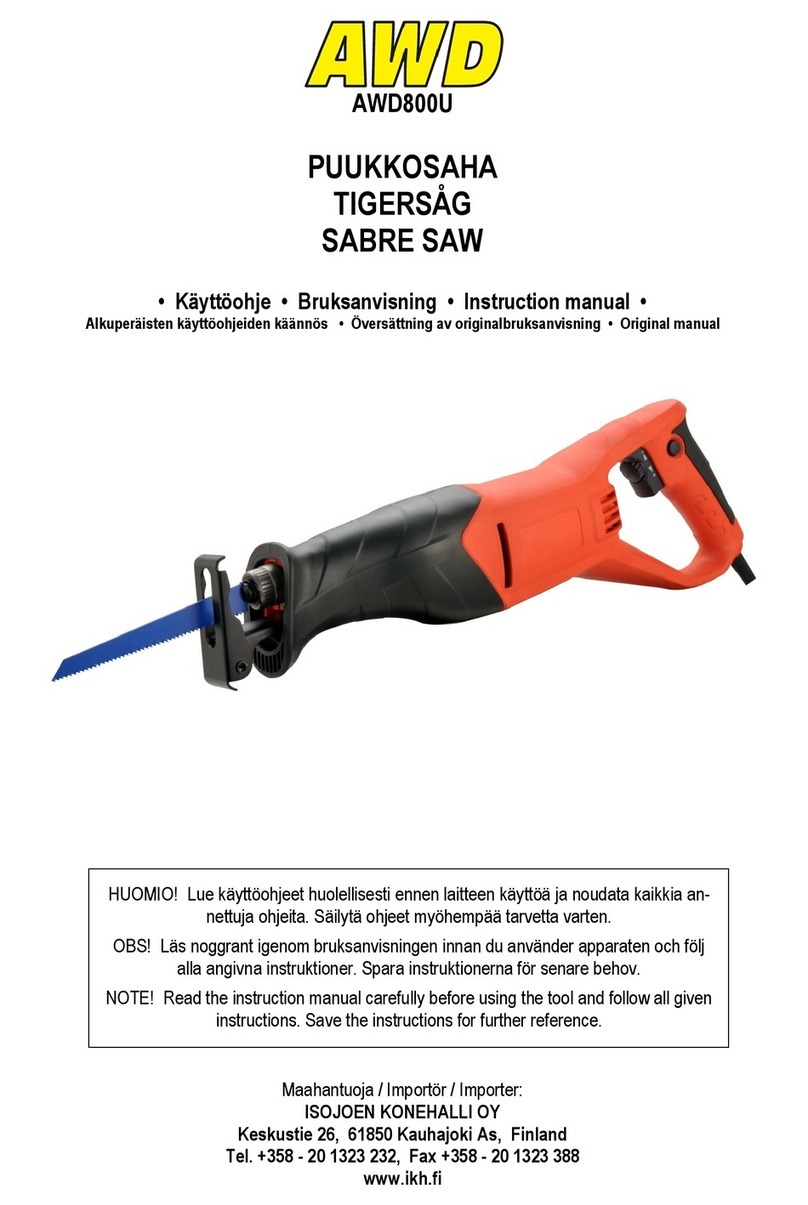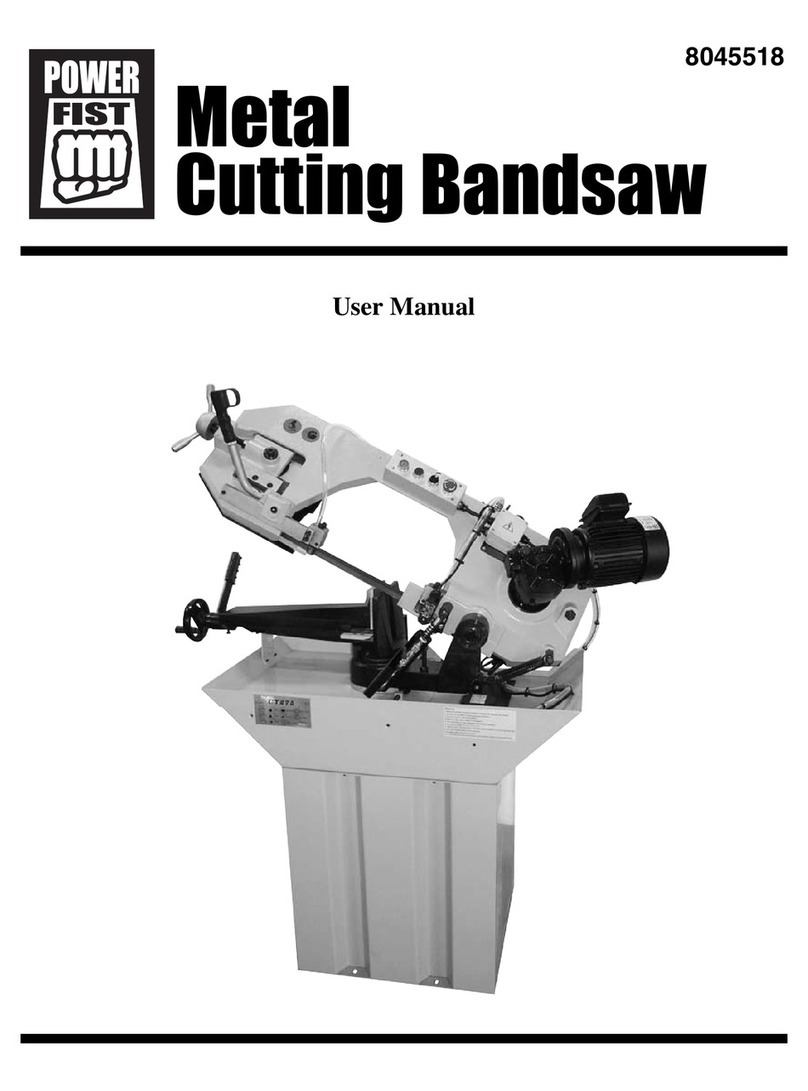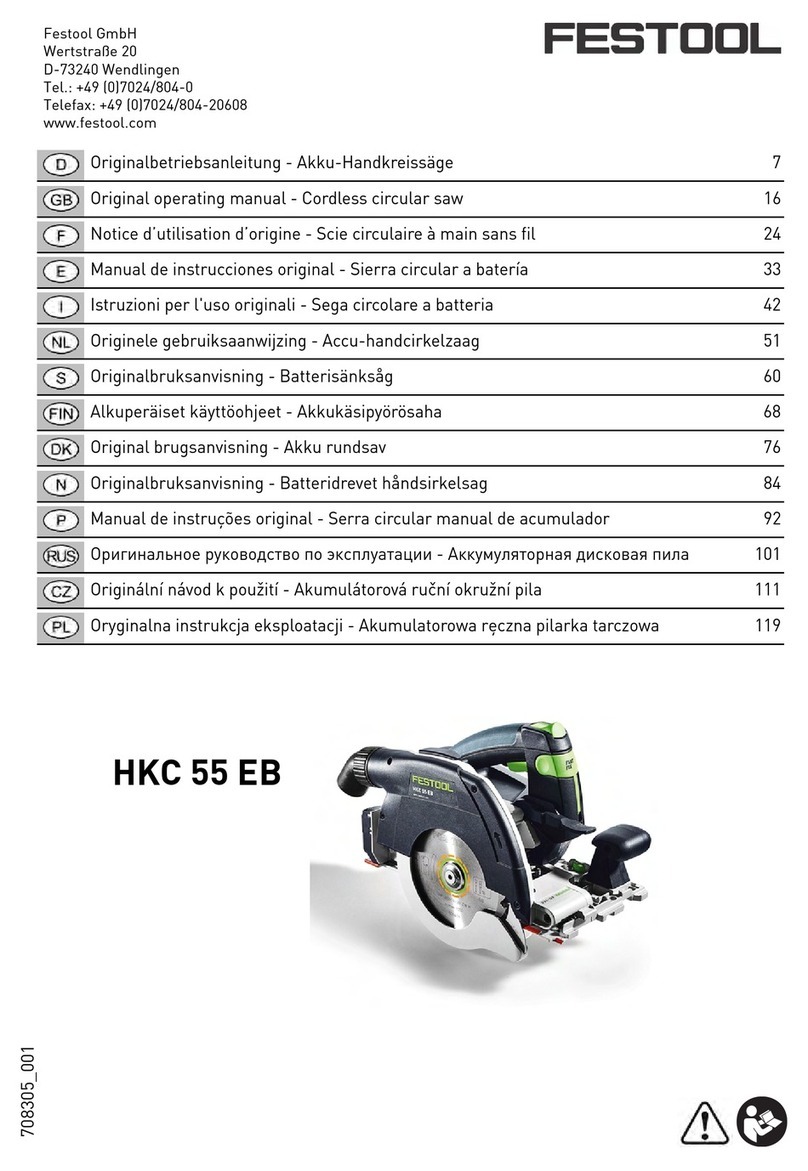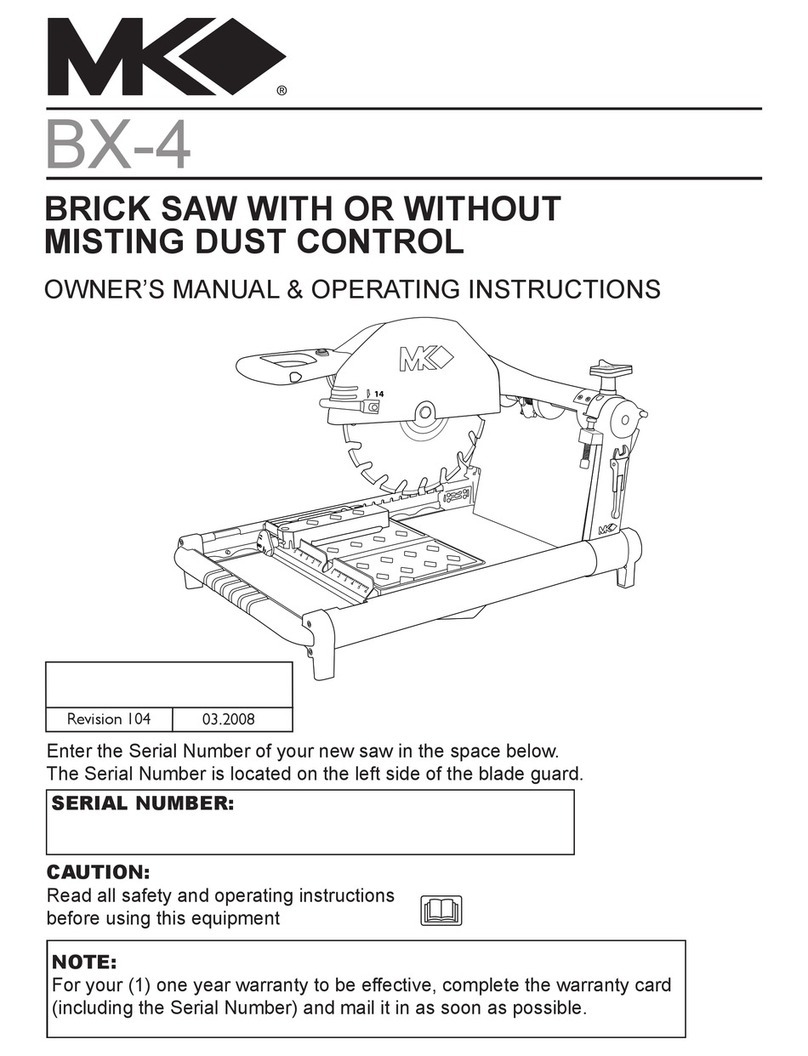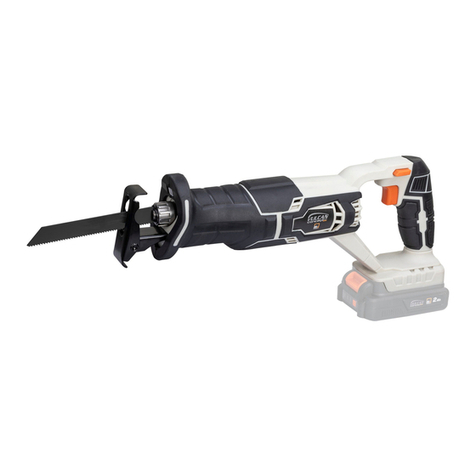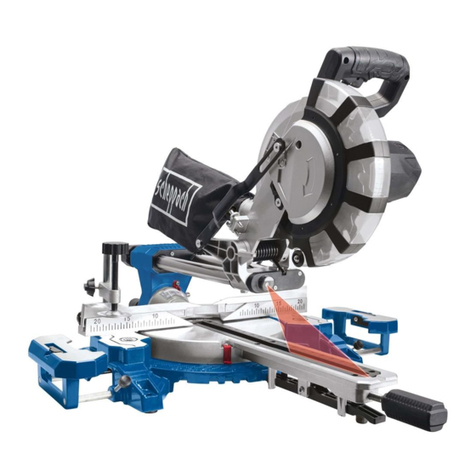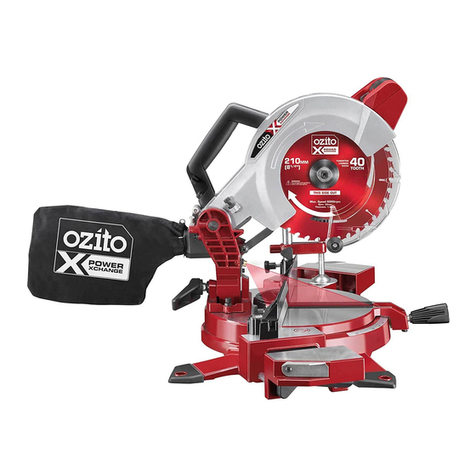Jefferson JEFSWCFF14-110A User manual

User Manual
v.1.1
JEFSWCFF14-110A
JEFSWCFF14-230A


USER MANUAL v.1.1
JEFSWCFF14-110A / JEFSWCFF14-230A
14" / 355mm CUT OFF SAW
www.jeffersontools.com 3
OVERVIEW
• 14" (355mm) cut-off saw for DIY & professional use
• Available in 110V & 230V
• Powerful 2480W Motor
• Ideal for cutting a variety of metallic materials including:
steel pipe, box section, angle iron, steel bars etc.
• Supplied with a Ø355mm abrasive metal cutting disc
• Heavy-duty cast steel base & saw arm
• Fitted with adjustable mitre vice
• 0° & 45° left / right clamping & cutting angles
• Ergonomic soft grip control handle
• Spindle lock for convenient blade replacement
• Safe operation with dead man’s trigger control & blade guard
• Portable fold-down design with carry handle
Equipment Overview
1. Trigger Switch
2. Upper Blade Guard
3. Lower Blade/Spark Guard
4. Cutting Blade/Disk 14" (355mm)
5. Vice Nut
6. Vice Handle
7. Fence
8. Padded Foot
9. Base / Floor
10. Depth Stop
11. Fold-Down Lock
12. Spindle Lock
13. 2480W Motor
14. Lock-Off button
SPECIFICATIONS
JEFSWCFF14-110A JEFSWCFF14-230A
Input Supply: 110V / 50~60hz 230V / 50~60hz
Plug: UK 16A UK 13A
Motor Power: 2480W / 3.2HP
No Load Speed: 3800rpm
Disc / Wheel Type: Fibre-Reinforced Metal Cutting
Disc Dimensions: Ø355 x 3 x 25.4mm (Bore)
Sound Pressure Level: LpA: 94.3.7dB (A)
Sound Power Level: LwA: 107.3dB (A)
Vibration Level: K=1.5m/s²
Net Weight: 20kg
CUTTING CAPACITIES:
45° (Angle): 56mm
45° (Bar): 50mm
45° (Pipe): Ø80mm
45° (Square Box): 50 x 50mm
45° (Rectangle Box): 80 x 50mm
90° (Angle): 100mm
90° (Bar): 105mm
90° (Pipe): Ø120mm
90° (Square Box): 105 x 105mm
90° (Rectangle Box): 90 x 130mm
Please Note: The vibration measurement was made under standard conditions in accordance with: BS EN 61029-1:2009. The declared vibration total value has been measured in accordance
with a standard test method and may be used for comparing one tool with another. The declared vibration total value may also be used in a preliminary assessment of exposure.
1
2
6
8
4
57
13
3
9
14
12
10
11

USER MANUAL v.1.1
JEFSWCFF14-110A / JEFSWCFF14-230A
14" / 355mm CUT OFF SAW
www.jeffersontools.com
4
SAFETY GUIDELINES
Please read and ensure that you understand all of the operating instructions, safety precautions and warnings in this
Instruction Manual before operating or maintaining this equipment. An accident can often be avoided by recognizing
a potentially hazardous situation before it occurs, and by observing appropriate safety procedures. Hazards that
must be avoided to prevent bodily injury or machine damage are identied by warnings on the equipment and in this
Instruction Manual. Never use this equipment or modify it in any way that has not been specically recommended by
the manufacturer. Contact Jefferson Tools for all information relating to the repair and maintenance of this equipment.
Contact a qualied electrician for advice on any issues relating to electrical safety in your working environment.
Electrical Safety
Ensure that you check the equipment thoroughly to ensure it is safe and fit for purpose before each use. It is important
that you inspect all plugs, sockets, power cables and electrical fittings for wear and damage and repair or replace any
defective components. The risk of electric shock can be minimised by the correct use of the appropriate electrical safety
devices.
• We recommend that you t a Residual Current Circuit Breaker (RCCB) in the main distribution board and that a Residual Current Device
(RCD) is used when operating this equipment.
• The Electricity at Work Act 1989 includes legislation that places legal implications on employers to ensure the safety of electrical devices in
the workplace. The regulations dictate that all portable equipment must be inspected regularly and tested to ensure that it is safe for use.
'Portable equipment' means any electrical item that can be moved and this is often referred to as Portable Appliance Testing (PAT). PAT
testing should be carried out regularly on this equipment by trained, authorised personnel, as required by the legislation.
• The Health and Safety at Work Act 1974 states that it is the responsibility of the owner of electrical appliances to ensure that both the
equipment and working environments are maintained to ensure safe operation at all times.
• Check that all equipment cables are secure, correctly insulated, free from damage, and protected against short circuit and overload before
connecting to the power supply. Do not use worn or damaged cables, plugs, sockets or other ttings.
• Ensure that the power supply matches voltage requirements specied on the equipment and that the plug is wired correctly and tted with
the correct fuse.
• If the electrical fuse blows, ensure it is replaced by an identical type of fuse with the same rating.
• Never pull or manoeuvre this equipment into position using the power cable.
• Ensure the power cable is kept away from heat, oil and sharp edges.
• We recommend that the equipment is connected directly to the power supply without the use of extension leads as the resulting voltage drop
can reduce motor performance.
• Always disconnect the equipment from the power source before servicing, inspecting, maintaining, cleaning, replacing or checking any parts.
Safe Outdoor Use: For your protection if this tool is to be used outdoors it should not be exposed to rain, or used in damp locations. Do not place
the tool on damp surfaces. Use a clean, dry workbench if available. For added protection use a residual current device (R.C.D.) that will interrupt
the supply if the leakage current to earth exceeds 30mA for 30ms. Always check the operation of the residual current device (R.C.D.) before using
the machine. If an extension cable is required it must be a suitable type for use outdoors and so labelled. The manufacturer’s instructions should
be followed when using an extension cable.
Vibration Safety
When using this machine the operator can be exposed to high levels of vibration transmitted to the hand and arm. It is possible that the operator
could develop “Vibration white nger disease” (also know as "Raynaud syndrome"). This condition can reduce the sensitivity of the hand to
temperature as well as producing general numbness. Prolonged or regular users of this machine should monitor the condition of their hands
and ngers closely. If any of the symptoms become evident, seek immediate medical advice. The measurement and assessment of human
exposure to hand-transmitted vibration in the workplace is given in: BS EN ISO 5349-1:2001 and BS EN ISO 5349-2:2002. Many factors can
inuence the actual vibration level during operation e.g. the work surfaces condition and orientation and the type and condition of the machine
being used. Before each use, such factors should be assessed, and where possible appropriate working practices adopted. Managing the followig
factors can help reduce the effects of vibration when using this equipment:
Handling
• Handle the machine with care, allowing the machine to do the work.
• Avoid using excessive physical effort on any of the machine’s controls.
• Consider your security and stability, and the orientation of the machine during use.
Work Surface
Consider the work surface material; its condition, density, strength, rigidity and orientation before operation. Ensure that the saw is setup to work
on a strong, stable, clean work surface.
WARNING: The vibration emission during actual use of the power tool can differ from the declared total value depending on the ways in which the
tool is used. The need to identify safety measures and to protect the operator are based on an estimation of exposure in the actual conditions of
use (taking account all parts of the operating cycle, such as the times the tool is switched off, when it is running idle, in addition to trigger time).

USER MANUAL v.1.1
JEFSWCFF14-110A / JEFSWCFF14-230A
14" / 355mm CUT OFF SAW
www.jeffersontools.com 5
Working Environment
Ensure that the work area is clean, dry, well-lit and has good ventilation. Cluttered or dark working areas increase the risk of injury when using this
equipment.
Do not operate power tools in environments with explosive atmospheres, such as in the presence of ammable liquids, gases or dust. Power
tools create sparks which may ignite the dust or fumes.
Ensure that pets, animals, children and bystanders are kept away while from the working environment when the saw is in use. Avoid any
distractions that may lead to inattention when operating this equipment.
Storage
Ensure that the saw is disconnected from the power supply and stored in a safe, dry location out of the reach of children when not in use.
Personal Safety
Stay alert, focused and watch what you are doing and use common sense when operating this equipment.
Do not use a power tool while you are tired or under the inuence of drugs, alcohol or medication. A moment of inattention while operating power
tools may result in serious personal injury.
Always use suitable personal protective equipment when using this equipment. This would include suitably-rated eye and hearing protection, dust
masks, non-skid safety shoes with steel toe-caps, and hard hats if required in the working environment.
Prevent unintentional starting. Ensure the switch is in the off-position before connecting to the power source. Always disconnect from the power
source before moving or carrying out maintenance, cleaning or adjustments to this equipment.
Ensure that you remove the blade arbour locking key before connecting to the mains supply.
Do not overreach. Keep proper and secure footing and balance at all times. This enables better control of the power tool in unexpected
situations.
Dress properly. Do not wear loose clothing or jewellery. Keep your hair, clothing and gloves away from moving parts. Loose clothes,
jewellery or long hair can be caught in moving parts.
If devices are provided for the connection of dust extraction and collection facilities, ensure that these are connected and properly used. Use of
dust collection can reduce dust-related hazards.
WARNING: When using this machine, dust particles may be produced. In some instances, depending on the materials you are working
with, this dust can be particularly harmful. If you suspect that paint on the surface of material you wish to cut contains lead, seek professional
advice. Lead based paints should only be removed by a professional and you should not attempt to remove it yourself. Once the dust has been
deposited on surfaces, hand to mouth contact can result in the ingestion of lead. Exposure to even low levels of lead can cause irreversible brain
and nervous system damage. The young and unborn children are particularly vulnerable.
You are advised to consider the risks associated with the materials you are working with and to reduce the risk of exposure. As some materials
can produce dust that may be hazardous to your health, we recommend the use of an approved face mask with replaceable lters when using this
machine.
You should always:
• Work in a well-ventilated area.
• Work with approved safety equipment, such as dust masks that are specially designed to lter microscopic particles.
WARNING: The operation of any power tool can result in foreign objects being thrown towards your eyes, which could result in severe eye
damage. Before beginning power tool operation, always wear safety goggles or safety glasses with side shield or a full face shield where
necessary.

USER MANUAL v.1.1
JEFSWCFF14-110A / JEFSWCFF14-230A
14" / 355mm CUT OFF SAW
www.jeffersontools.com
6
General Equipment Safety
This product is classed as a Hand Operated Cut Off Saw and must only be used in this capacity. It must not be modied in any way, or used to
power any other equipment or drive any other accessories other than those mentioned in this Instruction Manual.
WARNING: This machine is not safe for use by persons (including children) with reduced physical, sensory or mental capabilities,
or lack of experience and knowledge, unless they have been given supervision or instruction concerning the safe use of the
machine by a person responsible for their safety and who is competent in its safe use. Any children in the working area should
be supervised to ensure that they do not have access to, and are not allowed to play with, this machine. Do not operate this
equipment under the influence of medication or alcohol.
Safety Warnings And Equipment Labels
It is important that you read all safety warnings and instructions supplied in this user manual and the equipment labelling. Failure to follow the
warnings and instructions may result in electric shock, re and/ or serious injury.
Save all warnings and instructions for future reference. The term “power tool” in the warnings refers to mains-operated (corded) power tool or
battery-operated (cordless) power tools.
Safe Operation
Do not force the saw. Use the correct saw and blade for your application. Using the correct equipment will ensure safe cuts and will prolong the
life of the blade and the saw.
• Carefully inspect the saw and the blade before each use. Do not operate the saw if any parts are missing. Do not operate the saw if any
damage is detected - contact Jefferson Tools, or your local dealer for any advice on repair.
• Keep hands away from cutting area and the blade during operation. Keep your second hand on the auxiliary handle, or motor housing. If both
hands are holding the saw, they cannot be cut by the blade.
• Do not reach underneath the workpiece. The guard cannot protect you from the blade below the workpiece.
• Adjust the cutting depth to the thickness of the workpiece. Less than a full tooth of the blade teeth should be visible below the workpiece.
• Never hold piece being cut in your hands or across your leg. Secure the workpiece to a stable platform. It is important to support the work
properly to minimize body exposure, blade binding, or loss of control.
• Always handle the saw using the insulated gripping surfaces when performing an operation where the blade may come into contact with
hidden wiring or its own cord. Contact with a “live” wire will also make exposed metal parts of the saw “live” and shock the operator.
• When ripping always use a rip fence or straight edge guide. This improves the accuracy of cut and reduces the chance of blade binding
• Always use compatible blades with the correct size and arbor hole shape (diamond versus round). Blades that do not match the mounting
hardware of the saw will not function correctly and will be potentially damaging to the saw and very dangerous for the operator.
• Check and ensure that the Blade Maximum RPM is compatible with the saw before use.
• Never use a damaged blade washers or arbor bolt. The blade washers and arbor bolt were specially designed for your saw to ensure
optimum performance and safe operation.
• Do not use deformed, cracked, worn or otherwise damaged blades.
• Never use the saw without the original guard protection system. Do not lock the moving guard in the open position. Ensure that the guard
operates freely without jamming.

USER MANUAL v.1.1
JEFSWCFF14-110A / JEFSWCFF14-230A
14" / 355mm CUT OFF SAW
www.jeffersontools.com 7
Preventing Kickbacks
Kickback is a sudden reaction to a pinched, bound or misaligned saw blade, causing the saw to jar, bounce or judder. When the blade is pinched
or bound tightly by the kerf closing down, the blade stalls and the motor reaction drives the unit rapidly back
toward the operator.
This potentially damaging or dangerous problem can occur if the blade becomes twisted or misaligned in the cut, the teeth at the back edge of the
blade can dig into the top surface of the workpiece causing the blade to climb out of the kerf and jump back towards the operator.
Kickback is the result of saw misuse and or incorrect operating procedures or conditions and can be avoided by taking proper precautions as
described below:
• Maintain a rm grip with both hands on the saw and position your arms to resist kickback forces. Position your body to either side of the
blade, but not in line with the blade.
• If the blades are binding, or when interrupting a cut for any reason, release the trigger and hold the saw motionless in the material until the
blades come to a complete stop. Never attempt to remove the saw from the work or pull the saw backward while the blades are in motion or
kickback may occur. Investigate and take corrective actions to eliminate the cause of blade binding.
• When restarting a saw in the workpiece, centre the saw blade in the kerf and check that the saw teeth are not engaged into the material. If
the saw blade is binding, it may walk up or kickback from the workpiece as the saw is restarted.
• Support large workpieces and panels to minimise the risk of blade pinching and kickback. Large pieces tend to sag under their own weight.
Supports should be placed under them on both sides, near the line of cut and near the edge of the panel
• Ensure blade depth and bevel adjusting locking levers are tight and secure before making a cut. If the blade adjustment shifts while cutting it
may cause binding and result in kickback.
• Do not use dull or damaged blades. Unsharpened or improperly set blades produce a narrow kerf causing excessive friction, blade binding
and kickback.
• Use extra caution when making a “plunge cut” into existing walls or other blind areas. The protruding blade may cut objects that can cause
kickback.
• Check the lower guard for proper closing before each use. Do not operate the saw if the lower guard does not move freely and close
instantly. Never clamp or tie the lower guard into the open position. If the saw is is accidentally dropped, the lower guard may be bent. With
the saw disconnected from the power supply, check the lower guard and make sure it moves freely and does not touch the blade or any
other part, in all angles and depths of cut. If an issue is detected or the guard does not move freely the guard or blade may be damaged or
tted incorrectly. Repair before reusing the saw.
• Check the operation of the lower guard spring. If the guard and the spring are not operating properly, they must be serviced before use. The
lower guard may operate sluggishly due to damaged parts, gummy deposits, or a build-up of debris.
• The lower guard may be retracted manually only for special cuts such as “plunge cuts” and “compound cuts.” Raise the lower guard and as
soon as blade enters the material, the lower guard must be released. For all other sawing, the lower guard should operate automatically.
• Always observe that the lower guard is covering the blade before placing saw down on a bench or the oor. An unprotected, coasting blade
will cause the saw to walk backwards, cutting whatever is in its path. Be aware of the time it takes for the blade to stop after switch is
released.
UNPACKING
Upon receipt of the equipment, ensure all components are present and have remained undamaged in transit. Retain the packing materials and
packaging in case future transportation of the equipment is necessary.
We recommend that the packaging is kept, at least within the period of the warranty guarantee. Store the user manual in a safe location for future
reference.
PLEASE NOTE: This packaging contains sharp objects. Take care when unpacking. The saw is also quite heavy and may require two individuals
to safely remove from the cardboard packaging.

USER MANUAL v.1.1
JEFSWCFF14-110A / JEFSWCFF14-230A
14" / 355mm CUT OFF SAW
www.jeffersontools.com
8
OPERATION
Important: This equipment should only be used by competent operators who have
familiarised themselves with the safety and operating instructions contained in this manual.
Always wear appropriate Personal Protection Equipment including suitably rated eye,
hearing and respiratory protection for the materials you are cutting.
1. Check the equipment, blade, guards and cable/plug connection for damage or defects
prior to use. Do not use the saw if any problems are detected.
2. Ensure the saw is set-up as required, set the vice and fence angle as required.
3. Ensure that the workpiece is fully secured between the vice and the fence before
attempting to make any cuts with the saw.
4. Connect the saw to the power supply ensuring the rating matches the specications of
the saw.
5. Push the lock-off button and pull the trigger to engage the motor and cutting blade.
6. Carefully bring the disc down onto the workpiece and allow it to cut its way smoothly
through the material. Do not use excessive force.
6. Once the cut is complete, raise the arm to remove the cutting blade from the workpiece
before releasing the trigger to stop the motor. The cutting blade will continue to rotate for a
few seconds after the trigger is released. Ensure that you keep your hands etc. away from
the blade until it fully stops.
Adjusting the Cutting Angle:
The cutting angle can be adjusted using the hex key supplied to loosen the
two hex bolts and rotate the fence through 90° / 45°as shown below. Use
the guide to set the angle accurately and tighten the hex bolts to secure
the fence before cutting (See Fig.1).
Adjusting the Fence Position:
The standard distance between the vice and the fence is 175mm. You
can adjust this position by removing the two hex bolts using the hex
key provided. Move the fence as required to one of the other two xing
positions before tightening the hex bolts to secure the fence in position for
cutting. (See Fig.2).
Replacing a Cutting Blade
Important: Before attempting to remove a cutting blade always ensure
that the saw is switched off and disconnected from the power supply to
eliminate the risk of accidental starting during this operation.
1. Loosen and remove the two screws securing the Lower Guard /
Spark Shield (See Fig.3).
2. While holding the Spindle Lock lever, remove the disc bolt using
the hex key and turning in an anti-clockwise direction (See Fig.4 &
Fig.5).
3. Clean any debris or materials from the inner ange (checking
and ensuring it is in good working order).
4. Replace the blade by placing it on the mounting plate and
ensure thatit turns smoothly freely and on a level plane (without
wobbling) before reinserting the disc bolt and securley tightening in
a clockwise direction.
5. Replace the Lower Guard / Spark Shield by locating the center
pivioting section into the raised center section of the Upper Guard
and carefully re-securing the screws. (See Fig.6).
Fig 1: Adjusting the cutting angle
Fig 2: Adjusting the fence position
Fig 3: Remove the lower guard Fig 4: Holding the Spindle Lock
Fig 5: Removing the disc bolt Fig 6: Replacing the Lower Guard

USER MANUAL v.1.1
JEFSWCFF14-110A / JEFSWCFF14-230A
14" / 355mm CUT OFF SAW
www.jeffersontools.com 9
MAINTENANCE
WARNING:
Ensure that the power supply is disconnected before carrying out any repair or maintenance on this equipment. Ensure that
all maintenance and repairs are carried out by qualied technicians using only Jefferson approved replacement parts (Please
refer to parts list and diagram supplied later in this manual.)
Check that all safety features and guards are operating correctly on a regular basis. Only use this machine if all guards/safety features are fully
operational. Check for misalignment or binding of moving parts, breakage of moving parts and any other condition that may affect the power tools
operation. If damaged, have the power tool repaired before use. Many accidents are caused by poor tool maintenance. All motor bearings in this
machine are lubricated for life. No further lubrication is required.
Use a clean, slightly damp cloth to clean the plastic parts of the machine. Do not use solvents or similar products which could damage the plastic
parts.
WARNING: Do not attempt to clean by inserting pointed objects through openings in the machine’s casings etc. The saw's air vents should
be cleaned using compressed dry air. Excessive sparking may indicate the presence of dirt in the motor or worn out carbon brushes. If this is
suspected have the machine serviced and the brushes replaced by a qualied technician with Jefferson recommended brushes.
Checking & Adjusting the Depth Stop
Transportation & Storage
For ease and convenience, when transporting or storing the machine, the cutting head can be held in the ‘down’ position using the Fold Locking
Knob.

USER MANUAL v.1.1
JEFSWCFF14-110A / JEFSWCFF14-230A
14" / 355mm CUT OFF SAW
www.jeffersontools.com
10
PARTS LIST & DIAGRAM
# Description Qty # Description Qty
1Radial Rivet 1 48 Hexagonal Screw 2
2Pivoting Handle Bead 1 49 Rocker Arm 1
3Radial Rivet 1 50 Spindle Deector 1
4Pivoting Handle 1 51 Hexagon Nut 1
5Movable Nut 1 52 Plug 1
6Hexagonal Bolt 2 53 Cable Guard 1
7Standard Spring Washer 4 54 Cable Fixer 1
8Springy Column Pin 1 55 Screw 1
9Back Nut 1 56 Screw 1
10 Ploe 1 57 Spindle Deector 1
11 Bearing 1 58 Big Gear 3
12 Rotor 1 59 Bearing 1
13 Bearing 2 60 Front Cover 1
14 Cross Screw 2 61 Woodruff Key 2
15 Standard Spring Washer 4 62 Spindle 1
16 Rimq Ring 1 63 Hexagon Screw 4
17 Stator 1 64 Movable Cover 1
18 Spring 2 65 Connecting Screw 2
19 Flat Washer 7 66 Connecting Rod Bolt 2
20 Screw 4 67 Short Connection Rod 2
21 Back Cover 1 68 Flower Washer 2
22 Screw 4 69 Screw 1
23 Brush Holder 2 70 Tension Spring 2
24 Carbon Brush 2 71 Long Connection Rod 1
25 Carbon Brush Cover 2 72 Plastic Washer 1
26 Screw 5 73 Small Moving Cover 1
27 Left Handle 1 74 Hexagon Nut 4
28 Inductor 2 75 Big Moving Cover 1
29 Capacitor 1 76 Flat Washer 1
30 Switch 1 77 Spindle Deector 1
31 Soft Stator 1 78 Lower Flange 1
32 Right Handle 1 79 Wheel 1
33 Movable Pin 1 80 Upper Flange 4
34 Spring 1 81 Samll Flange 4
35 Movable Pin 1 82 Mud Guard 1
36 Split Pin 1 83 Hex Screw 1
37 Movable Clamp 1 84 Rod Bracket 1
38 Hex Nut 1 85 Flat Washer 1
39 Gauge Board 1 86 Hex Bolt 1
40 Hexagonal Screw 3 87 Base 1
41 Standard Spring Washer 2 88 Rubber Foot 1
42 Flat Washer 2 89 Torsion Spring 1
43 Hexagonal Screw 1 90 Fixed Cover 1
44 Locking Pin 1 91 Housing 1
45 O Shaped Rings 1 92 Screw 1
46 Ball-Shape Plastic Part 1 93 Springy Deector 1
47 Column Pin 1

USER MANUAL v.1.1
JEFSWCFF14-110A / JEFSWCFF14-230A
14" / 355mm CUT OFF SAW
www.jeffersontools.com 11

USER MANUAL v.1.1
JEFSWCFF14-110A / JEFSWCFF14-230A
14" / 355mm CUT OFF SAW
www.jeffersontools.com
12
ENVIRONMENTAL PROTECTION
Recycle any packaging and unwanted materials instead of disposing of them as waste. All tools, accessories and packaging
should be sorted, taken to a recycling centre and disposed of in a manner which is compatible with the environment.
When the product becomes completely unserviceable, reaches the end of its working life and requires disposal, drain off any uids
(if applicable) into approved containers and dispose of the product and the uids according to local regulations.
WEEE Waste Electrical and Electronic Equipment Statement
Information on Disposal for Users of Waste Electrical & Electronic Equipment
This symbol on the product(s) and / or accompanying documents means that used electrical and electronic products should not
be mixed with general household waste. For proper treatment, recovery and recycling, please take this product(s) to designated
collection points where it will be accepted free of charge.
For private households:
Dispose of this product at the end of its working life and in compliance with the EU Directive on Waste Electrical and Electronic Equipment
(WEEE). Contact your local solid waste authority for recycling information for this equipment. Disposing of this product correctly will help
save valuable resources and prevent any potential negative effects on human health and the environment, which could otherwise arise from
inappropriate waste handling. Please contact your local authority for further details of your nearest designated collection point. Penalties may be
applicable for incorrect disposal of this waste, in accordance with you national legislation.
For business users in the European Union:
If you wish to discard electrical and electronic equipment, please contact your dealer or supplier for further information.
Information on Disposal in other Countries outside the European Union:
This symbol is only valid in the European Union. If you wish to discard this product please contact your local authorities or dealer
and ask for the correct method of disposal.
RoHS (2014/35/EU - Restriction of Hazardous Substances)
Based on randomly-sampled examination of the evaluated product, the results of Lead, Cadmium, Hexavalent chromium,
Polybrominated biphenyls (PBB), Polybrominated diphenyl ethers (PBDE) in tested samples comply with the limits as set by RoHS
Directive 2011/65/EU ANNEX II; recasting 2002/95/EC.
EU DECLARATION OF CONFORMITY
We, Jefferson Professional Tools & Equipment, as the authorised European Community
representative of the manufacturer, declare that this equipment conforms to the requirements of
the following:
2006/42/EC - Machinery Directive
2014/30/EU - Electromagnetic Compatibility (EMC)
2011/65/EU - RoHS Directive
Signed By:
Date: 14.06.2022
Name and address of manufacturer
or authorised representative:
Jefferson Professional Tools & Equipment
24 Lisgorgan Lane, Upperlands, BT46 5TE,
Tel: +44 (0)1244 646 048 (UK)
+353 (0)1473 0300 (ROI)
Email: [email protected].
RoHS

USER MANUAL v.1.1
JEFSWCFF14-110A / JEFSWCFF14-230A
14" / 355mm CUT OFF SAW
www.jeffersontools.com 13
Jefferson Professional Tools & Equipment, or hereafter "Jefferson" warrants its customers that its products will be free of defects in workmanship
or material. Jefferson shall, upon suitable notication, correct any defects, by repair or replacement, of any parts or components of this product
that are determined by Jefferson to be faulty or defective.
This warranty is void if the equipment has been subjected to improper installation, storage, alteration, abnormal
operations, improper care, service or repair.
Warranty Period
Jefferson will assume both the parts and labour expense of correcting defects during the stated warranty periods below.
All warranty periods start from the date of purchase from an authorised Jefferson dealer. If proof of purchase is unavailable from the end user, then
the date of purchase will be deemed to be 3 months after the initial sale to the distributor.
1 Year:
14" / 355mm CUT OFF SAW •JEFSWCFF14-110A •JEFSWCFF14-230A
90 Days
• All replacement parts purchased outside of the warranty period
Important: All parts used in the repair or replacement of warranty covered equipment will be subject to a minimum of 90 days cover or the
remaining duration of the warranty period from the original date of purchase.
Warranty Registration / Activation
You can register and activate your warranty by visiting the Jefferson Tools website using the following address:
www.jeffersontools.com/warranty and completing the online form. Online warranty registration is recommended as it eliminates the need to
provide proof of purchase should a warranty claim be necessary.
Warranty Repair
Should Jefferson confirm the existence of any defect covered by this warranty the defect will be corrected by repair or replacement at an
authorized Jefferson dealer or repair centre.
Packaging & Freight Costs
The customer is responsible for the packaging of the equipment and making it ready for collection. Jefferson will arrange collection and
transportation of any equipment returned under warranty. Upon inspection of the equipment, if no defect can be found or the equipment is not
covered under the terms of the Jefferson warranty, the customer will be liable for any labour and return transportation costs incurred.
These costs will be agreed with the customer before the machine is returned.
*Jefferson reserve the right to void any warranty for damages identified as being caused through misuse
Warranty Limitations
Jefferson will not accept responsibility or liability for repairs made by unauthorised technicians or engineers. Jefferson's liability under this
warranty will not exceed the cost of correcting the defect of the Jefferson products.
Jefferson will not be liable for incidental or consequential damages (such as loss of business or hire of substitute equipment etc.) caused by
the defect or the time involved to correct the defect. This written warranty is the only express warranty provided by Jefferson with respect to its
products.
Any warranties of merchantability are limited to the duration of this limited warranty for the equipment involved.
Jefferson is not responsible for cable wear due to flexing and abrasion. The end user is responsible for routine inspection of cables for possible
wear and to correct any issues prior to cable failure.
LIMITED WARRANTY STATEMENT

USER MANUAL v.1.1
JEFSWCFF14-110A / JEFSWCFF14-230A
14" / 355mm CUT OFF SAW
www.jeffersontools.com
14
Claiming Warranty Coverage
The end user must contact Jefferson Professional Tools & Equipment (Tel: +44 (0)1244 646 048 (UK), +353 (0)1473 0300 (ROI) or their nearest
authorised Jefferson dealer where final determination of the warranty coverage can be ascertained.
Step 1 - Reporting the Defect
Online Method:
• Visit our website www.jeffersontools.com/warranty and complete the Warranty Returns form. You can complete the form online and submit it
to us directly or download the form to print out and return by post.
Telephone Method:
Contact your Jefferson dealer or sales representative with the following information:
• Model number
• Serial number (usually located on the specification plate)
• Date of purchase
A Warranty Returns form will be sent to you for completion and return by post or fax, together with details of your nearest authorised Jefferson
repair centre. On receipt of this form Jefferson will arrange to collect the equipment from you at the earliest convenience.
Step 2 - Returning the Equipment
It is the customer's responsibility to ensure that the equipment is appropriately and securely packaged for collection, together with a copy of
the original proof of purchase. Please note that Jefferson cannot assume any responsibility for any damage incurred to equipment during
transit. Any claims against a third party courier will be dealt with under the terms & conditions of their road haulage association directives.
Please note: Jefferson will be unable to collect or process any warranty requests without a copy of the original proof of purchase.
Step 3 - Assessment and Repair
On receipt, the equipment will be assessed by an authorised Jefferson engineer and it will be determined if the equipment is defective and in need
of repair and any repairs needed are covered by the warranty policy. In order to qualify for warranty cover all equipment presented must have been
used, serviced and maintained as instructed in the user manual.
Where repair is not covered by the warranty a quotation for repair, labour costs and return delivery will be sent to the customer (normally within 7
working days).
Note: If the repair quotation is not accepted Jefferson Professional Tools & Equipment will invoice 1 hour labour time at £30 per hour plus return
carriage costs (plus VAT).
In cases where no fault can be found with the equipment, or, if incorrect operation of the equipment is identified as the cause of the problem, a
minimum of 1 hour labour at £30 per hour plus carriage costs will be required before the equipment will be despatched back to the customer.
Any equipment repaired or replaced under warranty will normally be ready for shipment back to the customer within 7 working days upon receipt
of the equipment at an authorised Jefferson Repair centre (subject to part availability). Where parts are not immediately available Jefferson will
contact you with a revised date for completion of the repair.
General Warranty Enquiries
For any further information relating to Jefferson warranty cover please call +44 (0)1244 646 048 (UK) or +353 (0)1473 0300 (ROI) or send your
Disclaimer:
The information in this document is to the best of our knowledge true and accurate, but all recommendations or suggestions are made without
guarantee. Since the conditions of use are beyond their control, Jefferson Tools® disclaim any liability for loss or damage suffered from the use of
this data or suggestions. Furthermore, no liability is accepted if use of any product in accordance with this data or suggestions infringes any patent.
Jefferson Tools® reserve the right to change product specifications and warranty statements without further notification. All images are for
illustration purposes only.


Jefferson Professional Tools & Equipment
24 Lisgorgan Lane,
Upperlands,
BT46 5TE
Tel: +44 (0)1244 646 048 (UK) / +353 (0)1473 0300 (ROI)
Email: [email protected]
IMPORTANT! SAFETY FIRST!
Before attempting to use this product please read
all the safety precautions and operating instructions
outlined in this manual to reduce the risk of fire,
electric shock or personal injury.
www.jeffersontools.com
www.jeffersontools.com
This manual suits for next models
1
Table of contents
Other Jefferson Saw manuals
